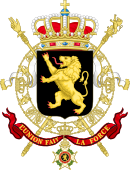| |||||||||||||||||||||||||||||||||||||||||||||||||||||||||||||
| Turnout | 91.08% | ||||||||||||||||||||||||||||||||||||||||||||||||||||||||||||
|---|---|---|---|---|---|---|---|---|---|---|---|---|---|---|---|---|---|---|---|---|---|---|---|---|---|---|---|---|---|---|---|---|---|---|---|---|---|---|---|---|---|---|---|---|---|---|---|---|---|---|---|---|---|---|---|---|---|---|---|---|---|
All 150 seats in the Chamber of Representatives 76 seats needed for a majority | |||||||||||||||||||||||||||||||||||||||||||||||||||||||||||||
This lists parties that won seats. See the complete results below. | |||||||||||||||||||||||||||||||||||||||||||||||||||||||||||||
40 of the 71 seats in the Senate | |||||||||||||||||||||||||||||||||||||||||||||||||||||||||||||
This lists parties that won seats. See the complete results below.
| |||||||||||||||||||||||||||||||||||||||||||||||||||||||||||||
 |
|---|
|
|
|
|
| Timeline |
| See also |

Federal elections were held in Belgium on 10 June 2007. Voters went to the polls in order to elect new members for the Chamber of Representatives and Senate.
Eligible voters were Belgian citizens 18 years and older. There was a legal electoral threshold of 5% for political parties to meet to receive representation, but in several election districts the real electoral threshold is higher than the legal, due to the small number of seats to be elected in the particular district. The 150 members of the Chamber of Representatives were elected from 11 electoral districts. The 40 Senate members were elected from the Dutch (25) and Francophone (15) electoral colleges.
Of the Flemish parties, the alliance of Christian Democratic and Flemish party (CD&V) and the New-Flemish Alliance (N-VA) received an increased share of the vote from the previous election, held in 2003. The CD&V/N-VA list was headed by Yves Leterme, and became the largest political formation in Belgium, thus leading the coalition talks for a new government.[1] Vlaams Belang received more votes than in the previous election, but lost one seat. Groen! was able to return to parliament and newcomers Lijst Dedecker surprised most by immediately grabbing six seats, including one in the Senate. Prime minister Guy Verhofstadt's "purple coalition," consisting of his Open Flemish Liberals and Democrats (Open Vld) alliance list and Socialist Party – Different (sp.a/spirit), was punished in the election, with the sp.a/spirit alliance losing somewhat more than Verhofstadt's Open Vld alliance. The day after the election, Verhofstadt handed in the resignation of his government to King Albert II.[2][3] SP.A leader Johan Vande Lanotte resigned from his leadership position as well that day.[4]
The Francophone situation did not mirror its Flemish counterpart. While Verhofstadt's Open Vld struggled, its Francophone sister party Mouvement Réformateur managed to defeat the long-dominant Parti Socialiste (PS), although the PS remained strong in Hainaut and Liège. The Humanist Democratic Centre brought in a positive result as well, but the biggest gains were for the environmentalist party Ecolo.
The overall outcome of the elections was that the liberal fraction (MR, Open Vld) became the largest group in parliament with, followed by the Christian Democrats (CD&V, cdH) and N-VA with 40 seats. The electoral alliance between the Flemish CD&V and N-VA parties became the biggest single parliamentary grouping (25 seats for CD&V and 5 for N-VA).
- ^ "Belgian PM concedes defeat". CNN.com. 2007-06-11. Retrieved 2007-06-15. [dead link]
- ^ "Belgian premier to hand in resignation". CNN.com. 2007-06-11. Retrieved 2007-06-15. [dead link]
- ^ "King accepts PM's resignation". Vrtnieuws.net. 2007-06-11. Retrieved 2007-06-15.
- ^ "Socialists opt for opposition". Vrtnieuws.net. 2007-06-11. Retrieved 2007-06-15.

